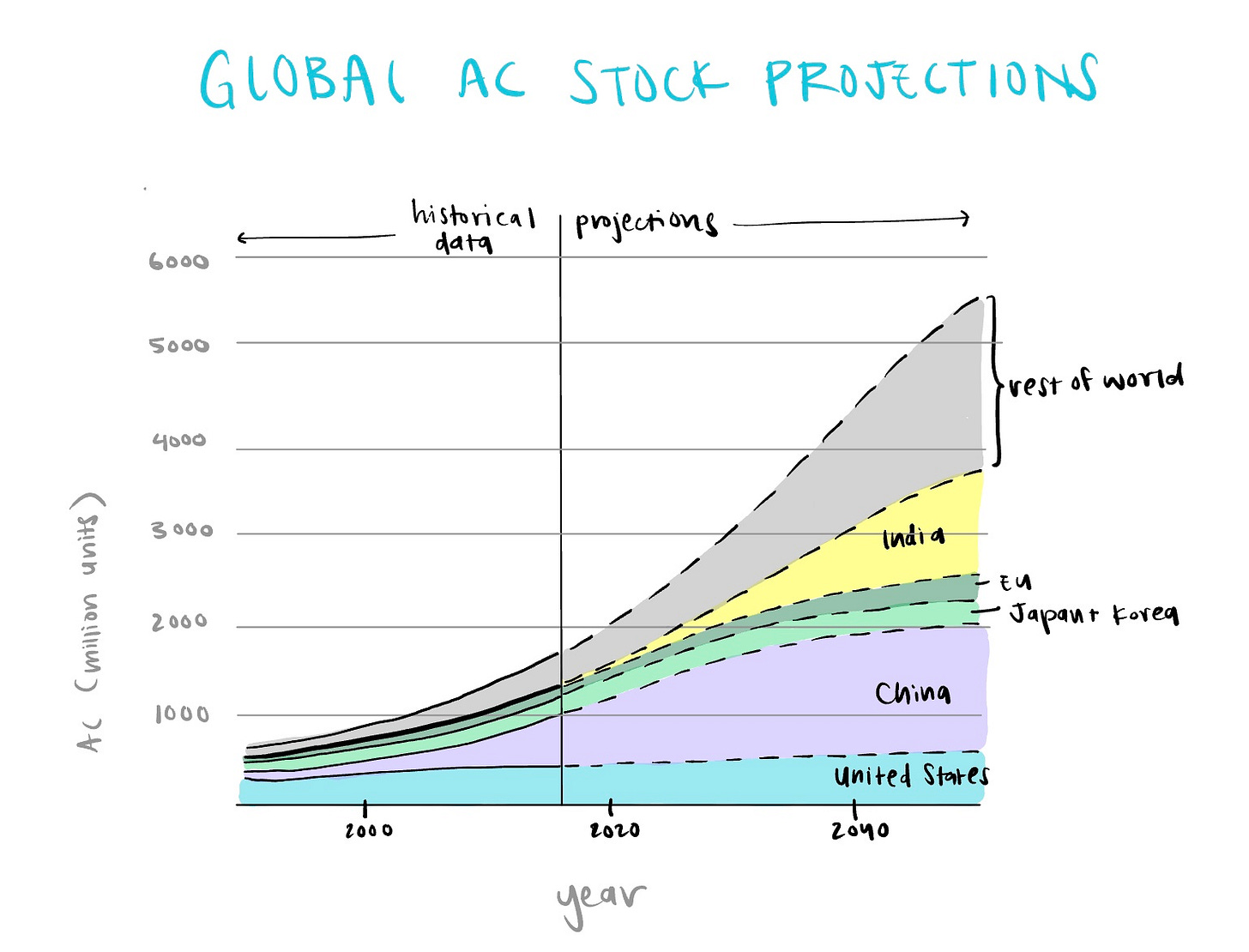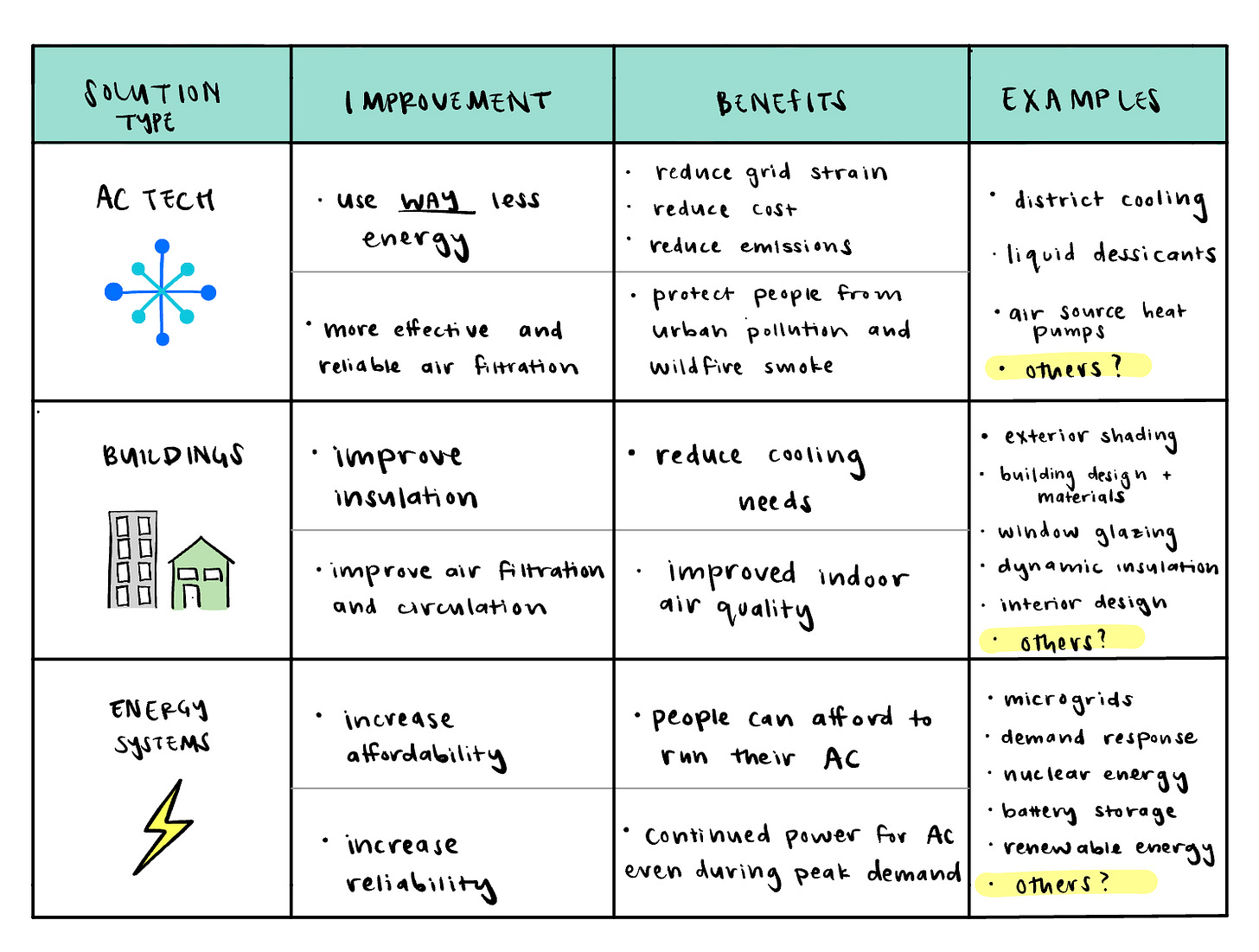Climate solutions only work if we use them. So some of our Street Notes will highlight demand trends that we're noticing through our travels and interviews. The goal is to give you the real-life data and stories you need to invent, invest in, or purchase climate resilience technologies that are responsive to people's desires and needs.
AC Hopping
Since we launched Parachute x Streetlife, we've visited 10 cities and conducted hundreds of hours of interviews. One behavioral pattern has become impossible to ignore: AC hopping (as in air conditioning hopping).
The idea of AC hopping isn’t foreign to most people — it's when people escape the heat by moving from one air-conditioned space to another, and spend as little time outdoors or in un-air-conditioned spaces as possible. And who can blame us? Even the most effective outdoor cooling solutions (so far) won't turn a humid 115F degree day into a breezy 75F.

AC hopping is built into many of our lives, and has made the issue of extreme heat seem minor and manageable. We wake up in air conditioned homes, take air-conditioned cars to air-conditioned offices, and then hang out in air-conditioned cafes and restaurants. We've (literally) insulated ourselves from the problem.
But AC has serious limitations that we need to solve for.
Here's some of what we've learned so far:
1. AC uses a lot of energy — this strains the grid, contributes to emissions, and can make it prohibitively expensive to run.
We recently interviewed Dr. Cheryl Holder, the Co-Chair of Miami-Dade County's Climate and Heat Health Task Force, who shared stories of patients who had to choose between running their AC and paying for medication. We've heard similar stories in nearly every interview we've conducted.
2. When the power goes out, so does the AC.
And ironically, heat waves dramatically increase the risk of power outages. During last week's historic heatwave in California, residents were asked to keep their homes at 78F to avoid blackouts. Seems like a lose-lose situation.

3. AC hopping looks different for different people, especially in lower income communities.
Outdoor and warehouse workers, lower income households, and unhoused people often lack access to AC in their workplaces or homes. For them, AC hopping relies on cooling centers, public pools, buses, or libraries for some brief relief from the heat. Even then, facilities in low-income or minority areas are often closed due to lack of staff. This creates AC double jeopardy for our most vulnerable populations. For example, in New York’s lower-income South Bronx neighborhood, 24% of residents lack AC, and few have cars to get to local pools. A few miles down in the Upper East Side, one of the city’s wealthiest neighborhoods, 4% of households lack AC. Heat kills 350 New Yorkers each year, but Black New Yorkers are twice as likely to die from heat as white residents. People’s access to AC is a life or death matter, literally.
4. Having good AC doesn't mean we have good air.
As we travel with our air quality monitors, our worst readings haven't been when we’ve biked next to highways or walked through busy downtown streets; they happen in air conditioned coffee shops, apartments, and offices. This is a common theme across every single city we’ve visited (receipts below). We spend 90% of our time indoors, so we should ensure those spaces have clean air, right?

Even with these limitations, AC use is only going up.
In fact, AC demand and usage will likely explode over the coming decades — from 1.6 billion units around the world today to 5.6 billion units in 2050. (Honestly, if you’re running a climate fund and NOT investing in clean, efficient, low-energy AC technology, you’re missing an opportunity).

Some people in the environment and climate space may find these numbers frightening (emissions! consumption! the grid!). But we think this increase in AC use is a good thing, because AC works to keep people cool — we don't want people to die. We just need to make some improvements.
You know the drill, we're all about solutions.
Given the overwhelming pattern of AC hopping combined with the limitations of AC, we've sketched out a space of solutions that are, in our opinion, some of the highest-leverage ways we can build resilience to climate change:
These solutions create a ton of co-benefits by making our AC hopping habit more sustainable, comfortable, healthy, and affordable. (If you missed our explanation of co-benefits last week, you can read it here). Each type of solution within this space can have massive impact alone, but their benefits compound when we deploy these solutions together to create more resilient cities.
Solutions Highlights:
🏬 District Cooling - District cooling is a high-efficiency cooling solution that can be applied at large scales — like buildings, neighborhoods, or cities. There are some big companies doing this around the world, but domestically, we're excited by local utilities like District Energy in St. Paul, MN, or Austin Energy in Austin, TX.
🪟Window Glazing - Minimizing heat gain through windows increases the energy efficiency of buildings and reduces cooling needs. Lyn got to see Panelite's ClearShade technology in action at Raleigh Union Station. It's really beautiful inside and out, AND it increases solar heat gain control by 75%!.
🏢 Curtain Walls - From aluminum-framed patterned materials to beautifully curved glass, curtain walls are non-structural elements that envelope the exterior of a building — letting in light and keeping out heat. Sonam was impressed by the Bullitt Center in Seattle (the greenest commercial building in the world!), with an energy use intensity that's 70% lower than most other Seattle buildings. Its Schuco high performance glass eliminates thermal bridging and external shades act like eyelids that adapt to the outdoor conditions. You can’t control the elements, but you can control which ones come in!
❄️ Heat Pumps - Sleek, quiet, and affordable heat pumps use a condensing liquid to absorb excess heat indoors and transfer it outdoors. Midea and Gradient recently won a bid from the New York City Housing Authority (a city unto itself with 500,000+ residents across 2,200 public housing buildings), to replace outdated heating oil systems with clean and green technologies.
📈 Demand Response - We’ve both received our fair share of text messages this summer from the local authorities in New York and Los Angeles with pleas to turn off our appliances and conserve energy. Software startups like OhmConnect automate and incentivize this process — using AI to manage a vast network of smart devices and paying utility customers to reduce their energy when the grid is stressed. The company saw a 90% disconnect rate during California’s heat emergency last week!
🪵 Cedar Wood Buildings - The Tsimshian Native Americans in Fairbanks, Alaska have used cedar wood for centuries to keep their homes warm in the winter and cool in the summer. The heavy log structures with Thermo-Lam 4-ply designs have tremendous thermal mass, which creates an insulating effect. Bonus points: lumber producers have been replacing harvested trees so diligently over the last few decades that North American forests have actually grown by 20% since 1970 — cedar wood is now one of the world’s most renewable building materials.
Call to Innovation:
In our research, we found recent studies showing potential applications of mass timber products (a category of wood building materials) as dynamic insulation. Apparently, we can design these materials to act as heat exchangers, meaning they bring in fresh air while keeping buildings cool inside (Sources: 1, 2). We haven't found any companies so far that are actively marketing a product that does this yet though. If you're an engineer or potential founder — reach out to us as we’ve got some ideas and resources for you!
What's Next:
We're interviewing policymakers, scientists, and entrepreneurs that are deploying these solutions in the real world. We’ll be sharing more of these local gems from streets and neighborhoods across the globe as we continue our travels. If you're building or investing in these spaces, we want to talk to you! Reach out at hello@parachute.earth.






